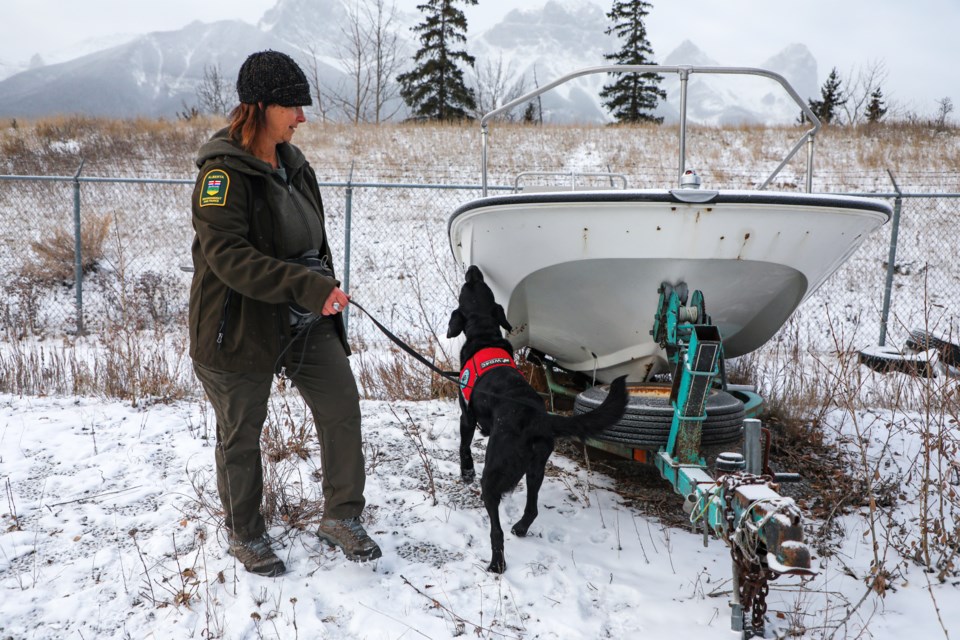The provincial government is setting up a new task force to tackle aquatic invasive species and increasing the number of watercraft inspection stations in a bid to keep zebra and quagga mussels from making their way into Alberta.
This decision to invest $2.5 million to increase watercraft inspection and detection follows Parks Canada’s recent move to shut down all waterbodies in Yoho and Kootenay national parks to fishing and watercraft like canoes, kayaks, and paddle boards until March 31, 2025, to fight against the spread of whirling disease, which can result in mass fish die-offs.
The province plans to boost the number of dedicated watercraft inspectors from 35 to 50 this year, and increase the number of inspection stations from five to seven this year, with four more next year.
A roving inspection crew will be created to crisscross the province to follow-up on notices from the Canadian Border Service Agency and increase inspections at high traffic spots, and an additional dog and handler team will be added to the invasive species K-9 inspection unit.
Officials say the provincial aquatic invasive species task force will work with partners to discuss critical topics like how to improve border protections, ways to strengthen the province’s rules and programs, and whether stronger penalties, restrictions or other approaches are needed.
“These invasive species pose a real and costly threat to other species living in our lakes and rivers, as well as to the water and irrigation infrastructure that we depend on for our economy and for drought and flood protection,” said Rebecca Schulz, Alberta’s environment and protected areas minister in a press release on Thursday (March 28).
Currently, Alberta is free of zebra and quagga mussels; however, increased detections in Idaho and Manitoba south of the border last year are increasing the risk of invasive mussels being introduced into the province.
Banff National Park monitors for aquatic invasive species, and while there are mandatory inspections in certain locations like Lake Minnewanka and self-certifications elsewhere, there are no stricter regulations in place like in Yoho and Kootenay national parks at this time.
Waterton Lakes National Park introduced more stringent regulations effective April 1, banning all non-motorized craft from outside the national park and prohibiting fishing in streams and rivers to reduce risk of aquatic invasive species. Fishing is still allowed in park lakes.
Under the new rules, businesses operating inside Waterton Lakes National Park and users whose watercraft do not leave park boundaries can still launch in the park. However, owners must take an aquatics invasive species course and have their watercraft inspected by Parks Canada to qualify for this exemption.
Last October, Parks Canada closed all water access in Yoho and Kootenay national parks following the discovery of a case of whirling disease in non-native brook trout in Emerald Lake just west of Field in British Columbia a month earlier. This was the first detection of whirling disease in B.C.
Further testing detected whirling disease in the Kicking Horse River, Wapta Lake, Finn Creek, Monarch Creek and the confluence of the Emerald and Kicking Horse River.
Justin Brisbane, a spokesperson for Parks Canada, said an in-depth analysis was done over the winter to determine how to best mitigate the risk posed by whirling disease to sensitive aquatic ecosystems and vulnerable species at risk in Yoho and Kootenay national parks.
“The closures are designed to help protect fish species vulnerable to whirling disease, including several trout species and Kokanee salmon,” he said in a press release.
“The closures will also provide Parks Canada with an opportunity to conduct further sampling and monitoring actions, which will inform future management actions.”
Whirling disease death rates can reach 90 per cent in young fish. There is no treatment for the fatal disease, which is very difficult to eradicate once established.
Named for the circular swimming patterns of infected fish, whirling disease is not spread directly between fish, but a parasite is spread through contact between fish and a freshwater worm.
Once the parasites have invaded the cartilage of the fish, it can result in deformities in the jaws, head, gill cover, and body, and can also cause the tails of infected fish to turn black. It can also impair the nervous tissue, resulting in the characteristic whirling swimming behaviour.
After the deadly disease was discovered in Johnson Lake in 2016 – the first known case in Canada – the small lake near the Banff townsite was drained and all fish were killed. The main concern was it would cause harm to at-risk species like bull trout and westslope cutthroat trout.
Thought to have been introduced from Europe, whirling disease was first detected in the United States in 1958. It became a major concern in the 1990s when losses of up to 90 per cent of the wild rainbow trout in several streams in Colorado and Montana were attributed to whirling disease.



